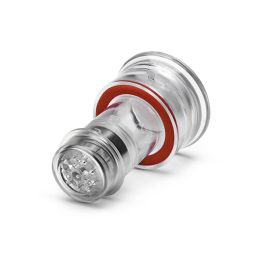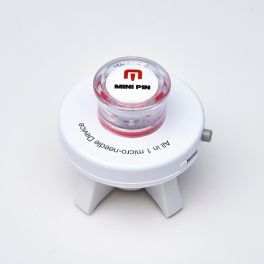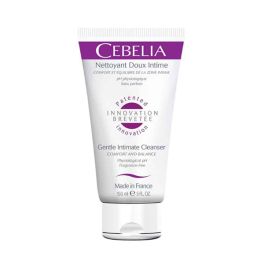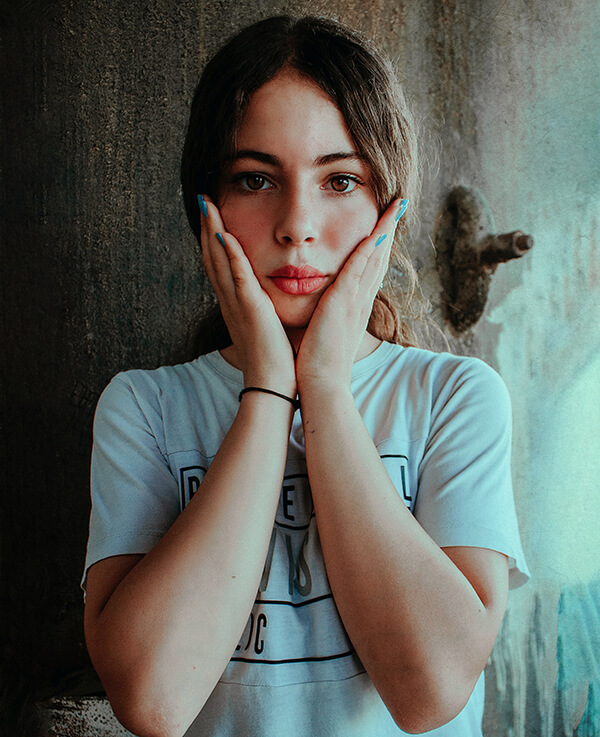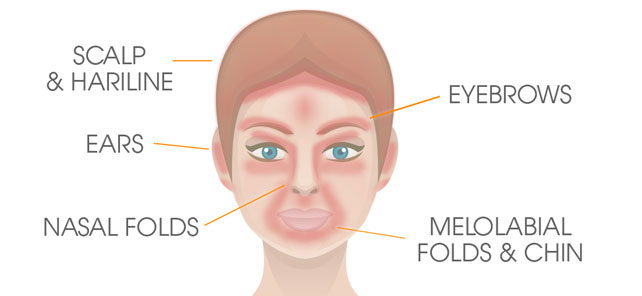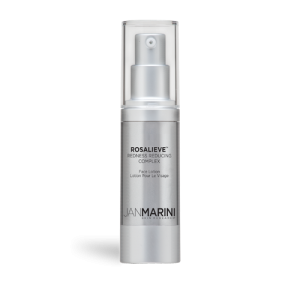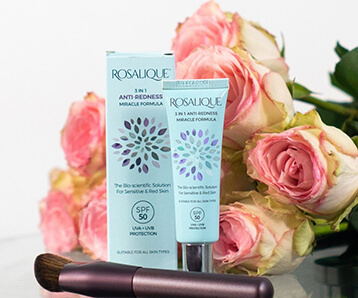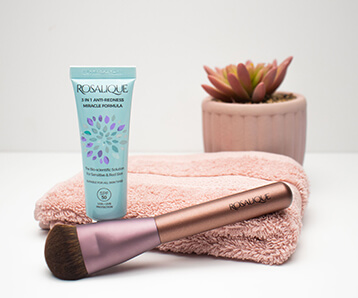How To Get Rid Of Redness On Your Face & What's Causing It Posted on 22 Apr 2023
Facial redness can be one of those things that just seems to rear its unwanted head every so often and flare up for no apparent reason
If you find yourself searching on Google "why do I have skin redness" or "how to get rid of redness on face" then you've landed in exactly the right place. A red complexion can be caused due to a number of reasons so it's not always easy to work out why you have it, to then solve how to get rid of it. Here we take a deep dive into all the causes of skin redness, what are the symptoms, and how best to control them.
Rosacea Related Redness
Symptoms
Rosacea is probably the first thing that comes to mind when you try to self-diagnose facial redness. Although it might be that, it’s not always the cause. Rosacea is an autoimmune disease skin disorder that affects approximately 13 million Americans and is growing rapidly. This often baffling disease can be difficult to treat and can cause severe emotional distress due to visible facial involvement.
The disease rosacea was originally called "acne rosacea." That name is no longer considered correct. Even though many aspects of rosacea may closely mimic the description and characteristics of acne, it is a completely separate entity. Rosacea is a common, chronic inflammatory disorder, usually affecting the central portion of the face and occasionally the V-shaped area of the chest, the back, and even the scalp. It is characterized by facial redness, telangiectasia (dilated capillaries/blood vessels), uneven texture, and sometimes lesions that look like acne papules and pustules. It is often difficult to diagnose rosacea because the lesions can so closely resemble acne. However, even though a rosacea papule or pustule may imitate acne, the key differentiation is that in rosacea, no microcomedone activity is present.
Common culprits of triggers are consuming alcohol, extreme temperatures (changing from hot to cold weather), hot drinks, drink alcohol, and spicy food are common triggers that can trigger facial redness.
Find out more about the different types of rosacea here
Treatments
As far as treatment goes, there is one major thing to know. There is no "cure" for Rosacea. However, it is both highly treatable and manageable. A major ongoing factor is to keep your skin barrier healthy and adopt an anti-inflammatory diet. This means a gentle cleanser, soothing moisturiser, and avoiding exfoliating skincare ingredients (but you may want to look into PHAs). Eminence Organic Calm Skin Chamomile Moisturiser, ZENMED Gentle Cleansing Cream are both highly effective. It is recommended to incorporate daily sunscreen and anti-inflammatory skincare ingredients like Vitamin C into your routine too. In severe cases, you may want to look into laser treatment or antibiotics as well as skincare products for real noticeable improvements.
Eczema Related Redness
Symptoms
Eczema is a chronic skin condition that causes the skin to become itchy, reddened, dry, and cracked. In more severe forms the skin can become broken, raw, and bleeding. Atopic eczema is the most common form of eczema and mainly affects children. It's usually inherited and affects parts of the body where the skin creases, such as the backs of the knees and the front of the elbows, as well as the chest, face, and neck. The exact cause of atopic eczema is unknown, but it often occurs in people who are prone to allergies ('atopic' means sensitivity to allergens). Also often seen in people who also have hayfever or asthma.
Treatments
Eczema can usually be easily managed at home. Try to avoid fragrance, soap, and detergents (or wear rubber gloves if you have to). Soaps and detergents remove the natural oils from the skin and the reason eczema happens is due to a damaged skin barrier. These products tend to make the skin dry and itchy, and more sensitive to irritants. Instead, use a thick emollient moisturiser as a soap substitute and add an emollient to a bath or shower. Switch to a non-bio washing detergent as bio can be irritating. Wear loose-fitting, cotton fabric clothes. Atopiclair Cream is a non-steriod anti-inflammatory cream that effectively treats eczema flare-ups by preventing loss of skin moisture for up to 72 hours and offers longer-lasting hydration by restoring your natural skin oils.
Redness From Too Much Exfoliating
Symptoms
We all need to exfoliate in order to reduce a build-up of dead skin cells however, even those with the toughest of skins can overdo it sometimes. If you've been using a lot of skin products recently such as Salicylic Acid, Glycolic Acid, at-home peels, peel pads, retinols, exfoliating cleansers, or even benzoyl peroxide, and found that suddenly your skin has become particularly reddened, dry, or extremely sensitive out of nowhere then this is probably the issue. You have weakened your skin barrier and caused it to become sensitive and vulnerable to infection.
Treatments
Your skin will recover eventually. To get things back on track quickly and prevent making your facial redness worse, put down the exfoliants for now and reinforce your barrier function with lots of moisture. We recommend incorporating Hyaluronic Acid, Niacinamide, and Azelaic Acid immediately and ongoing for optimal skin health. Don't forget that SPF is a daily essential too.
Contact Dermatitis
Symptoms
Contact dermatitis is a misunderstood condition. It can get confused with eczema but usually happens with poor-quality cosmetics and it is your skin's way of saying that it does not agree with a certain ingredient. The reaction usually occurs within a few hours or days of exposure to an irritant or allergen. It may be that the product is causing a general immune system allergic reaction or the product may be causing actual irritation to the skin. It commonly affects the hands, face, and eyes.
Treatments
Naturally, the best treatment here would be ceasing use of the product in question. This can be tough as it can be trial and error trying to work out what is actually causing the problem. Sometimes, this can be obvious as the reaction may happen immediately after using a certain product. In severe cases, you can visit a dermatologist for ingredient patch testing to see what exactly you are allergic to. This process can be a lengthy one but absolutely worth it.
Seborrheic Dermatitis
Symptoms
Not to be confused with the similarly named Contact Dermatitis, Seborrheic Dermatitis is an inflammatory reaction to excess Malassezia yeast, an organism that normally lives on the skin's surface. Seborrheic dermatitis can affect people of any age, though it’s most common in infants and adults between the ages of 30 and 60. Among adults and teens, the condition is more common in males. In infants, the condition usually clears on its own and doesn’t come back. In adults, however, Seborrheic Dermatitis usually follows a pattern of flaring and clearing that can last for years.
Seborrheic Dermatitis tends to form where the skin is oilier and has more oil glands. It can appear on the scalp but also affect oily areas of the body, such as the face, sides of the nose, eyebrows, ears, eyelids, and chest. It causes scaly patches, red skin, and stubborn dandruff.
You can read more about Seborrheic Dermatitis here
Treatments
Sebclair Cream and Sebclair Shampoo are the ideal treatments for SD. The Sebclair range is a non-steroidal range of clinically proven products specifically designed to manage the signs and symptoms of seborrheic dermatitis (SD), which has demonstrated both anti-inflammatory and antifungal properties (you need antifungals to lower excess yeast levels and subsequently reduce inflammation and redness).
Each product has been specifically formulated to manage the most common symptoms of Seborrheic Dermatitis such as scaling/flaking, reddening, burning, and pain in areas with a particularly high concentration of sebaceous glands such as the scalp, eyebrows, forehead, nasolabial folds, and trunk, which can all be affected by the condition. Sebclair contains a combination of natural and synthetic ingredients that work synergistically by helping to treat the signs and symptoms of SD. Sebclair helps to restore the normal skin barrier function by promoting moisture retention, which is beneficial to the healing process.
Genetic And Environmental Factors
Symptoms
Genetic flushing is a fairly simple one to diagnose but not so simple to treat. Do your parents have glowing red cheeks? Or, turn red after a few drops of alcohol or spicy foods? If you're nodding your head whilst reading this then chances are that your red skin is due to genetics.
Treatments
The best treatment here would be avoidance to the cause as much as possible. Obviously, that is easier said than done. If you do know that you are going to be out socialising and drinking alcohol then you could try taking an antihistamine prior to the evening to help migrate some of the flushing effects. Applying a green primer like Rosalique before makeup will help to mask some of the redness on your face too.
Excessive Sun Exposure
Symptoms
Been out in the sun all day with no sunscreen on or failed to reapply every 2 hours as recommended? You'll likely be suffering from a bad case of sunburn, redness, and possibly also a blistering rash.
Treatments
The best immediate solution is a cool compress, aloe vera, and a few days completely out of sunlight. Everyone should have some SkinCeuticals Phyto Corrective Masque in their bathroom cabinet, just in case, for emergencies. It is a must-have for clinics and post-procedure too.
Going forward, sun protection is absolutely essential every day regardless of whether it is a sunny day or not. Sunburn may fade however, the sun damage will last. You should choose a sunscreen that is broad-spectrum so that it protects you from both UVA and UVB rays.
Acne Related Redness
Symptoms
As if acne wasn't enough to contend with already, the facial redness and inflamed skin that comes along with it is just the icing on the cake. Facial redness occurs due to your body trying to fight the inflammation of blemishes.
Treatments
This is the one case where you’re allowed to pile on the ingredients you should avoid when dealing with the rest of this list. Ingredients such as Salicylic Acid, Azelaic Acid, and Glycolic Acid are your friends here to both reduce the redness and begin clearing your complexion. DermaTx Clarify Salicylic Cleanser and Jan Marini Bioclear Face Lotion are highly effective and recommended.
Blue light has also been clinically proven to reduce P.acnes bacterium (a bacteria that causes acne). You can read all about and purchase a LED light mask here.
Acne and how to treat it needs its entire own blog post so if you are trying to treat acne you should read a blog post here
Reducing Redness Effectively
If you need some further help regarding treating redness, skin irritation, or just general skin care advice then feel free to ask us! All the products featured above are available to purchase at Dermacare Direct with free tracked delivery via Royal Mail. We can help with our expert advice and top tips making your makeup shopping stress-free. You can contact us by live chat, email via [email protected], or pick up the phone now and call us on phone number 0116 251 4848 to speak directly with a friendly advisor.














